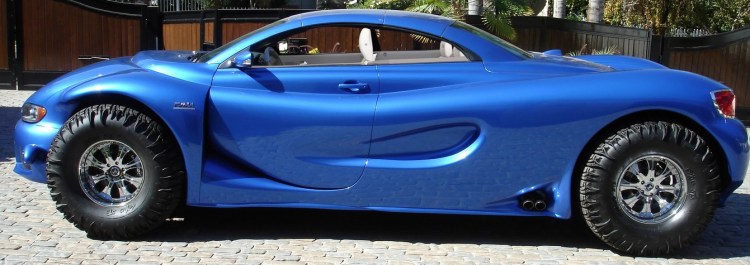The Los Angeles Auto Show opened to the public yesterday, showing off the latest auto bling to a city where cars are the ultimate status symbol.
More than a million visitors are expected to crowd the first major show of the auto season. On tap are the global debuts of the 2015 Mercedes S65, Jaguar F-Type Coupe, and Porsche Macan as well as new concept cars such as the Nissan Nismo. Only in L.A. may one see the locally produced Youabian Puma (pictured above), a 20-foot long convertible with tractor wheels selling for a cool $1.1 million.
Two months ago, the Frankfurt Auto Show presented European auto makers as leading technology innovators and adopters. German OEMs BMW, Audi, and Mercedes announced advances in autonomous driving, navigation, infotainment and ancillary services, and we saw an explosion of electronic componentry in cars. The cost of auto electronics has risen threefold in recent years and is projected to be over 50% of total bill of materials (BOM) cost for conventional vehicles in 10 years and 80% of hybrids.
As cars increasingly become technology hubs, the locus of auto innovation is migrating to technology centers such as Silicon Valley. This week Mercedes unveiled a new state-of-the-art R&D center in Sunnyvale and expects to double its workforce there in the next few years. Nissan, Ford and Audi have also opened R&D centers in Silicon Valley. Since 2010 General Motors and BMW have launched venture funds and Intel Capital has announced a Connected Car fund.
This year for the first time, the L.A. Auto Show sponsored a three-day Connected Car expo. The expo featured more startups and Connected Car technology startups than we saw in Frankfurt and included a fast pitch competition among eight Connected Car startups. Our favorite was the third place winner featuring a 12 year old CEO proposing a smartphone feature that rings an alarm when texting-and-driving.
Among the new technologies discussed and presented at the Connected Car expo:
1. Electronic Dashboards: Almost all cars demoed included an electronic display used primarily for audio, navigation, and phone auto sync features. Mercedes GT AMG was most advanced, using an electronic dashboard for the speedometer as well. All cars will soon adopt electronic dashboards as their cost is projected to decline below traditional dashboards by 2017. Yet the “user interface for cars needs to be completely refreshed,” according to Andreas Mai of Cisco. Electronic dashboards have the potential to be the nerve center of the car, offering expanded functionality, including personalized user interfaces, an app and infotainment center, driving performance metrics, car functions controls, and voice activated commands. “The company that creates the killer user interface will be the next $1 billion company in the auto sector,” according to Sven Beiker, Director of the Center for Automotive Research at Stanford.
2. Reengineering the Car: Luxury cars such as Mercedes contain over 100 million lines of code, more than Dreamliner airplanes and F35 fighter jets. This software controls and integrates a network of as many as 100 microprocessors running electronic control units (ECUs), a number that is expected to double in the next decade. Challenges abound as sensors proliferate and complexity increases. Over 100 pounds of wiring connect these separate ECUs. IBM claims that about 50% of warranty costs are related to electronics and their embedded software. Tesla is showing the value of reimaging the auto. Tesla’s modular design allowed it to do a late design upgrade from Nvidia’s Tegra 2 to Tegra 3 processors. Over-the-air updates will be a prerequisite for owners who wish to extend the useful life of Connected Cars. A new class of suppliers and systems integrators may emerge to help automakers reengineer their componentry and supply systems.
3. Semi-autonomous Driving: Nevada, Florida, and California have passed legislation permitting autonomous driving on public roads for test purposes. Google has a fleet with self-driving technology that has now logged over half a million miles. While fully autonomous driving may be decades away, BMW, Audi, and Volvo are poised to release semi-autonomous driving systems in 2014 that would allow hands free automation in stop-and-go traffic at speeds up to 25-35 mph. Cadillac plans to release Super Cruise to allow full range hands-free highway driving.
4. Local Services: As navigation systems become standard design-in features, automakers will offer local guides for shopping and entertainment services at a destination or along the route. Parking is a natural extension for navigation systems. At the LA Auto Show, Volvo announced this week a partnership with Parkopedia to help drivers find and navigate to parking when there is limited availability.
New auto technologies adopted in the next few years have the potential to alter our driving experience more than at any time in the past 50 years. The L.A. Auto Show offered a glimpse of what the next few years may offer. Much more is yet to come.
Paul Asel is managing partner of Nokia Growth Partners where he covers in investments in the U.S. and Asia focusing on technology for the mobile and auto sectors.


